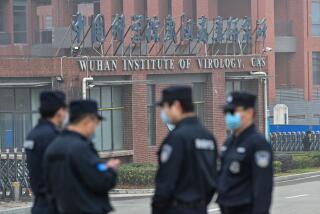Researcher Finding Little Evidence of New AIDS Virus : Medicine: In 15 of 17 cases studied, no link is found to the class of viruses that includes HIV. But work on AIDS-like disease is not finished.
- Share via
WASHINGTON — The AIDS researcher who has been studying the largest number of mystery cases of patients suffering from severe immune deficiency--but who show no signs of infection with either of the two known AIDS viruses--said Saturday he has found little evidence so far that a new AIDS-like virus is responsible.
Dr. David Ho, director of the Aaron Diamond AIDS Research Center in New York, said he has examined blood samples from 17 patients, and 15 of them have proved negative for the presence of a retrovirus, a special class of viruses that includes the human immunodeficiency viruses, which cause AIDS.
Two of the cases have shown traces of reverse transcriptase--a critical enzyme associated with retroviruses--but these need further clarification, Ho said. They could, for example, be readings of other blood cell enzymes that could be confused with reverse transcriptase, he said.
Human retroviruses are a category of viruses whose genetic material consists of RNA (ribonucleic acid), rather than the DNA (deoxyribonucleic acid) found in every other organism. When retroviruses enter a cell, they use an enzyme known as reverse transcriptase to copy their RNA into DNA, which is then integrated into the DNA of the host cell. In other words, the genetic material of the retrovirus becomes a permanent part of the host cell.
Ho’s findings now make it appear less likely than earlier believed that a new retrovirus is behind the cases, but Ho insisted it was premature to draw any final conclusions until all the scientific work is completed.
“We certainly have not tried all the possibilities,” he said. “We have run all the standard tests. But we cannot conclude (it is not a retrovirus) with a great deal of certainty yet.”
Furthermore, he stressed that there are still other possibilities.
“Not being able to find something doesn’t mean something doesn’t exist,” he said. “It could be any other agent, or it could have no infectious cause. We have to remain fairly open-minded.”
Ho is scheduled to discuss his preliminary results at a special meeting of scientists Friday in Atlanta called by the federal Centers for Disease Control.
“I want to show all our data next week, both positive and negative, and let people draw their own conclusions,” he said.
He also noted that, in many of the patients he is studying, the disease has not taken the same clinical course as AIDS. This strengthens the argument that these patients do not represent the rare subgroup of individuals who actually have AIDS, but in whom HIV-1 cannot be detected.
“You would think this would largely be a progressive disease, but many of the patients have stayed the same for several years,” Ho said.
This is uncharacteristic of AIDS, which produces “more problems, more symptoms, more infections and more lab abnormalities,” he said.
The puzzling new disorders first came to light during the eighth International AIDS Conference in Amsterdam last month, when scientists spoke anecdotally of at least several dozen cases of individuals who had become ill but who failed to test positive for either HIV-1 or HIV-2, raising the possibility that a new and undetectable infectious agent had suddenly emerged.
Experts have urged that the cases be kept in perspective, pointing out there have always been instances of patients with unexplained immune disorders. The Age of AIDS, however, with its increased surveillance and more sophisticated testing, may have simply focused more public attention on them, they said.
Initial reports described 11 such cases, six of them identified by the CDC and another five by Dr. Jeffrey Laurence of Cornell University Medical College.
During a hastily called special session at the international conference, Ho revealed that he had been quietly studying 11 such cases of patients in Los Angeles and New York. He has since added six cases--three more from New York and three from Colorado--to those under his scrutiny.
While several of the patients described by researchers had the same risk factors as for AIDS--they included homosexual men, intravenous drug users and blood transfusion recipients--there thus far appears to be no “clustering,” either by patients or geography.
Also during the Amsterdam meeting--but several thousand miles away in California--a team of UC Irvine scientists headed by Dr. Sudhir Gupta announced that they had isolated a previously unknown virus in patients with an AIDS-like disease. Gupta emphasized, however, that it was premature to pinpoint the virus as the cause of the disorders.
In the meantime, other scientists have expressed skepticism that Gupta has in fact discovered a new virus.
Gupta’s paper, released by the National Academy of Sciences, described the presence of what he called intracisternal viral particles. Some scientists have emphasized that such particles are not new, and have previously been described in human tissues.






